June 22nd Scots Book of Days
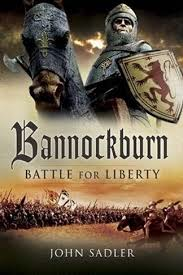 June 22 250 Alban first Martyr of Britain.
June 22 250 Alban first Martyr of Britain.
1265 Treaty of Pipton, Powys, Wales.
1314 Heading toward Bannockburn, Stirling, Scotland. English army marched rapidly to reach Stirling before Mowbray’s agreement expired on 24 June. By 22 June, it was at Falkirk, only 15 miles short of its objective.
Book cover. Edward 2nd’s host followed the line of the old Roman road, which ran through an ancient forest known as the Tor Wood, over the Bannockburn and into the New Park, a hunting preserve enclosed at the time of Alexander III. Bruce’s army had been assembling in the Tor Wood, an area providing good natural cover, from the middle of May. On Saturday, 22 June, with his troops now organised into their respective commands, 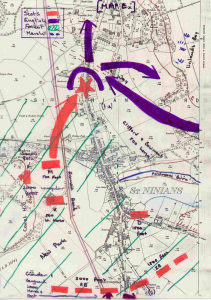 Bruce moved his army slightly to the north to the New Park, a more heavily wooded area, where his movements could be concealed and which, if the occasion demanded, could provide cover for a withdrawal. Cat and Mouse.
Bruce moved his army slightly to the north to the New Park, a more heavily wooded area, where his movements could be concealed and which, if the occasion demanded, could provide cover for a withdrawal. Cat and Mouse.
- Brus or Bruce 1050 2Stewart2Kennedy 2Montgomery2Blair 2Cochrane2Miller 2Simmons2Choate zoe ToaG
Tytler’s History of Scotland in Britannica continued; At New Park the ground was partly open, partly with trees, with the approach protected by a dangerous morass. The Scottish line of battle extended from south to north, and fronted east or south east. The right wing rested on a brook called Bannockburn, whose broken wooded banks secured the flank from the assault.
The left wing extended toward Stirling, was protected by rows of pits 3 feet deep, with sharp stakes driven and the points covered with sod. The right wing was commanded by Edward Bruce, the left win by James Douglas and Walter the Steward of Scotland; and Thomas Randolph, King Robert’s nephew, commanded the central division. King Robert Bruce commanded the reserve, with vassals of Carrick, men of the isles, Argyle and Kentire. The camp followers were with the baggage behind the hill at the rear of the Scottish army, which hill was still called the Gillies’ (or servants’) hill as of 1830.
Bruce victorious at Bannockburn – 1314. Bruce defeats Edward II at Bannockburn.
http://www.bbc.co.uk/scotland/history/wars_of_independence/bruce_victorious_at_bannockburn/
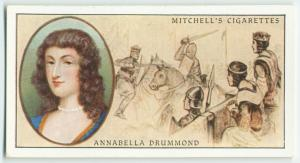 1368 David II Bruce reinforced the position of John and Annabella (nee Drummond) by providing them with the earldom of Carrick. John is afterwards Robert III King of Scots
1368 David II Bruce reinforced the position of John and Annabella (nee Drummond) by providing them with the earldom of Carrick. John is afterwards Robert III King of Scots
Annabella Drummond. Ancestress of Scots and English Royal lines.
1371 David II dies.
1402 – Battle of Nesbit Moor, Berwickshire, north of the River Tweed, forfeited George de 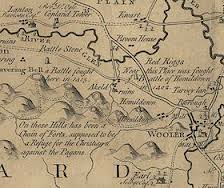 Dunbar, 10th Earl of March successfully led 200 English soldiers, mainly drawn from the garrison at Berwick-upon-Tweed, against 400 Scots returning from a raid on Northumberland. This clash took place on the Kimmerghame Estate in a field now named Slaughter Field. The estate is in the possession of the Swinton Family. To avenge this, Murdoch Stewart, Duke of Albany, goes to Homildon Hill. Border War.
Dunbar, 10th Earl of March successfully led 200 English soldiers, mainly drawn from the garrison at Berwick-upon-Tweed, against 400 Scots returning from a raid on Northumberland. This clash took place on the Kimmerghame Estate in a field now named Slaughter Field. The estate is in the possession of the Swinton Family. To avenge this, Murdoch Stewart, Duke of Albany, goes to Homildon Hill. Border War.
1534 to 1607 to 1641. Religious persecution laws adopted at various times in these years. The Act of Uniformity, the Test Acts and Penal Laws of England, (with jurisdiction into Ireland, Scotland and British colonies of Africa, India, and Americas), enforced by execution and torture, fine and prison, confiscation and transport to the plantations (American colonies, if ye weren’t already here) were, according to Edmund Burke “a machine of wise and elaborate contrivance, as well fitted for the oppression, impoverishment and degradation of a people, and the debasement in them of human nature itself, as ever proceeded from the perverted ingenuity of man.” Savage John (1869). Fenian Heroes and Martyrs. Patrick Donahoe. pp. 16. Bans on Catholics, Dissenters from the Established Church, (Nonconformists,
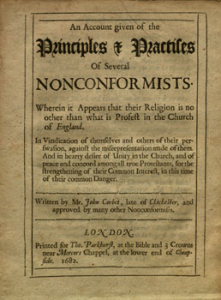 1682, London, printed for the Parkhurst, at the Bible near Mercers Chapel at the lowerend Cheapside.
1682, London, printed for the Parkhurst, at the Bible near Mercers Chapel at the lowerend Cheapside.
Presbyterians, Lutherans, Quakers, Covenanters, Methodists, Congregationalists, Jews, Anglicans 1650-1661, Baptists, along with slaves, felons, imbeciles. and foreigners) Ban on Catholics owning freehold land repealed by the Relief Act of 1793. Wikipedia. Penal Laws repealed 1829.
1622 – YYMA 46 – James Paterson’s History of the County of Ayr (p. 42), when describing the parish of Auchinleck, says, ‘Of the other smaller properties we shall give such notices as we have found of them: …Templeland, or Tempilland-Auchinleck as it was called of old, belonged, in 1588, to ‘Hew Craufurd of Templeland.”William Crawford
- Crawford of Drongan and Haining 1100 2douglas2Stewart 2Ruthven2Kinchin 2jared2Simmons 2Choate zoe
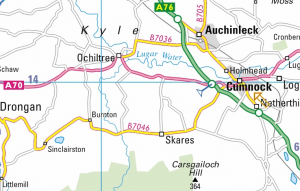 is mentioned in 1615 as creditor ‘for the ferme of blakestoun’ (Blackston lies just northwest of the present Templeland farm) and on 28 June 1622 Hugh Nisbet in Knevok-law was returned heir of entail ‘in liberties terrarum antiqui extentus de Tempilland alis nuncupatis Tempilland-Auchinleck, in fra parochiam de Auchinlek.’ In 1680, the farm passed into the family of William Wallace of Craigie; in the 18th century it was acquired by Sir James Boswell of Auchinleck.
is mentioned in 1615 as creditor ‘for the ferme of blakestoun’ (Blackston lies just northwest of the present Templeland farm) and on 28 June 1622 Hugh Nisbet in Knevok-law was returned heir of entail ‘in liberties terrarum antiqui extentus de Tempilland alis nuncupatis Tempilland-Auchinleck, in fra parochiam de Auchinlek.’ In 1680, the farm passed into the family of William Wallace of Craigie; in the 18th century it was acquired by Sir James Boswell of Auchinleck.
Boswell of Auchinleck Ayr 13c 2Arnot2Colville 2Semple 2Montgomerie2Cochrane 2Miller2Simmons 2Choate zoe ToaG
Ochiltree and Auchinleck
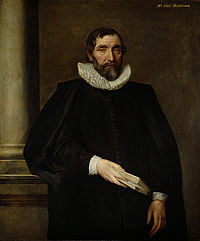 1662 Commissioner Middleton, some time in the month of June or July 1662, stooped so low as to procure an order of parliament, to raze and demolish a monument which was erected on Alexander Henderson’s grave in the Gray-friar’s church-yard of Edinburgh, in form of a quadrangular urn, inscribed on three sides; and because there was some mention thereon of the solemn league and covenant, which was all the length their malice could go against a man who had been near sixteen years in his grave. Biographia Scoticana: OR, A
BRIEF HISTORICAL ACCOUNT
OF THE
LIVES, CHARACTERS, and MEMORABLE
TRANSACTIONS of the most eminent
SCOTS WORTHIES, Noblemen, Gentlemen, Ministers, and others: From Mr. Patrick Hamilton, who was born about the year of our Lord 1503, and suffered martyrdom at St. Andrews, Feb. 1527, to Mr. James Renwick, who was executed in the Grass-market of Edinburgh Feb. 17, 1688. together with a succinct Account of the Lives of other seven eminent Divines, and Sir Robert Hamilton of Preston, who died about, or shortly after the Revolution. as also, An Appendix, containing a short historical Hint of the wicked Lives and miserable Deaths of some of the most remarkable apostates and bloody persecutors in Scotland from the Reformation to the Revolution. Collected from historical Records, Biographical Accounts, and other authenticated Writings:—The whole including a Period of near Two Hundred Years. By John Howie –
1662 Commissioner Middleton, some time in the month of June or July 1662, stooped so low as to procure an order of parliament, to raze and demolish a monument which was erected on Alexander Henderson’s grave in the Gray-friar’s church-yard of Edinburgh, in form of a quadrangular urn, inscribed on three sides; and because there was some mention thereon of the solemn league and covenant, which was all the length their malice could go against a man who had been near sixteen years in his grave. Biographia Scoticana: OR, A
BRIEF HISTORICAL ACCOUNT
OF THE
LIVES, CHARACTERS, and MEMORABLE
TRANSACTIONS of the most eminent
SCOTS WORTHIES, Noblemen, Gentlemen, Ministers, and others: From Mr. Patrick Hamilton, who was born about the year of our Lord 1503, and suffered martyrdom at St. Andrews, Feb. 1527, to Mr. James Renwick, who was executed in the Grass-market of Edinburgh Feb. 17, 1688. together with a succinct Account of the Lives of other seven eminent Divines, and Sir Robert Hamilton of Preston, who died about, or shortly after the Revolution. as also, An Appendix, containing a short historical Hint of the wicked Lives and miserable Deaths of some of the most remarkable apostates and bloody persecutors in Scotland from the Reformation to the Revolution. Collected from historical Records, Biographical Accounts, and other authenticated Writings:—The whole including a Period of near Two Hundred Years. By John Howie –
Alexander Henderson
1679 Battle of Bothwell Bridge over the river Clyde, between Covenanters and troops of Monmouth (TG51-246) 400 killed (TG51-247). 1200 prisoners. Ministers executed, prisoners sent to plantations (Barbadoes, and Carolinas). Shortly after this battle, Cameron and Cargill, two preachers, publicly excommunicated the king (Charles 2nd Stuart) for immorality, tyranny, breach of the covenant, and renounced allegiance. Tytler’s Britannica.
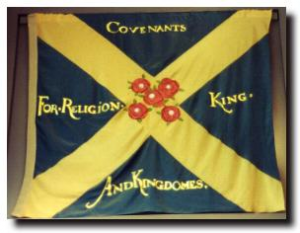 A banner which flew at the Battle of Bothwell Bridge in 1679, one of Scotland’s fiercest religious conflicts, has been restored by experts in the Scottish Museums Council. (Note that the illustration here is of another such banner, displayed in the Museum of Scotland). The restored banner had been displayed in Airdrie library in Lanarkshire and there had been concerns that the fragile state of the 323-year-old flag might result in it having to be removed from permanent public display. The banner has the motto “Nemo me impune lacessit” (nobody provokes me with impunity or, in Scots, “Wha daur meddle wi’ me”) and is one of only two known to have survived. More than 6,000 Covenanters gathered outside Hamilton in Lanarkshire on June 22, 1679. They were defending Presbyterianism from the forces loyal to King Charles I who was trying to introduce an English Episcopalian prayer book. www.rampantscotland.com
A banner which flew at the Battle of Bothwell Bridge in 1679, one of Scotland’s fiercest religious conflicts, has been restored by experts in the Scottish Museums Council. (Note that the illustration here is of another such banner, displayed in the Museum of Scotland). The restored banner had been displayed in Airdrie library in Lanarkshire and there had been concerns that the fragile state of the 323-year-old flag might result in it having to be removed from permanent public display. The banner has the motto “Nemo me impune lacessit” (nobody provokes me with impunity or, in Scots, “Wha daur meddle wi’ me”) and is one of only two known to have survived. More than 6,000 Covenanters gathered outside Hamilton in Lanarkshire on June 22, 1679. They were defending Presbyterianism from the forces loyal to King Charles I who was trying to introduce an English Episcopalian prayer book. www.rampantscotland.com
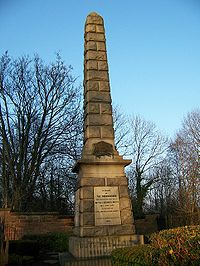 Heading toward Bothwell Bridge.
Heading toward Bothwell Bridge.
In honour of the Covenanters who fell at the Battle of Bothwell Bridge 22nd June 1678 in defense of Civil and Religious Liberty. Erected by Public subscription 1803.
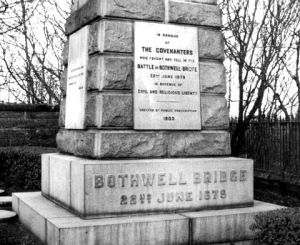 Note that Sir Walter Scott’s Tales of a Grandfather (History of Scotland abbreviated as TG at chapter 51) has the year as 1679, whereas this monument dates the battle at 1678.
Note that Sir Walter Scott’s Tales of a Grandfather (History of Scotland abbreviated as TG at chapter 51) has the year as 1679, whereas this monument dates the battle at 1678.
1684 sometime in the year, The Killing Times – 1684. The Abjuration Oath is issued by the Privy Council. All subjects are to swear allegiance to the king and renounce the Covenant. Failure to take the oath results in death. The Killing Times had begun. Video: The Sword and the Cross: Covenant or King.
http://www.bbc.co.uk/scotland/history/covenanters/the_killing_times/
The Killing Time was a period of conflict in Scottish history between the Presbyterian Covenanter movement, based largely in the south west of the country, (Ayrshire) and the government forces of Kings Charles II and James VII.
After the Restoration of 1660, episcopacy was reintroduced into the Church of Scotland, returning church governance to the situation that existed prior to the expulsion of the bishops by the Glasgow General Assembly in 1638 and overthrowing the Presbyterian form of organisation favoured by the Covenanters. Wikipedia.
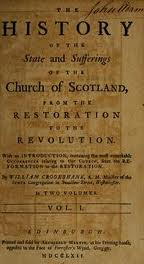 The period, roughly from 1680 to the Glorious Revolution of 1688, was subsequently called the Killing Time by Robert Woodrow in his The History of the Sufferings of the Church of Scotland from the Restoration to the Revolution, published in 1721-1722. It is an important episode in the martyrology of the Church of Scotland. Openlibrary.org
The period, roughly from 1680 to the Glorious Revolution of 1688, was subsequently called the Killing Time by Robert Woodrow in his The History of the Sufferings of the Church of Scotland from the Restoration to the Revolution, published in 1721-1722. It is an important episode in the martyrology of the Church of Scotland. Openlibrary.org
1711 Alexander Stuart FRS FRCP (1673– 15 September 1742) was a British natural philosopher and physicist. Born in Aberdeen, Scotland. 1708 Stuart started a medical degree at Leiden University, and graduated on 22 June 1711. 1740 awarded the Copley Medal by the Royal Society of London for “For his Lectures on Muscular Motion. As a further addition for his services to the Society in the care and pains he has taken therein’.
1738 – Robert Miller’s (II of St. Quivox) who died in 1732, left his only son Robert, (Miller III) who was served heir to his father’s estate on 22 June 1738. The senior Robert Miller’s (II of St. Quivox) will is preserved on pp. 138-142 of Vol. 51, August 19, 1731-May 26, 1736, of the Glasgow Testaments. It reproduces Robert 2nd’s marriage contract with Helen Meldrum, a list of debts owing to Robert 2nd , and an inventory of Robert 2nd property including ‘two little horses, both very [81 YYMA] old… of our Cowes..tuo young Cowes & ane Calf…household plenishing & furniture Including half ane Dozen Silver Spoons & a Silver Jug… .Sum old Books’ and an account of debts owing.
Where Robert [Miller] III spent the years between his father’s death
and his appearance in South Carolina (at age 24) is unknown; the minutes of Ayr Presbytery existed until recent years but cannot currently be located and his mother may have remarried and moved. His formal service of heir (the Latin text is in Ing. Ret. Reg. Vol. 65, fol. 45—June 1738, No. 19) may have been in connection with plans for emigration; it took place at an age younger (age 12) than was customary.
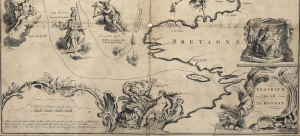 1745 June 22. PRINCE CHARLES EDWARD STUART embarked at Nantes on board La Doutelle, accompanied by the Duke of Atholl (M. of Tullibardine), Sir John MacDonald, Leneas MacDonald, Colonel Strickland, Sir Thomas Sheridan, Captain O’Sulivan, George Kelly, Mr. Buchanan (I. 201, 282), and Anthony Welch, the owner of the ship.
1745 June 22. PRINCE CHARLES EDWARD STUART embarked at Nantes on board La Doutelle, accompanied by the Duke of Atholl (M. of Tullibardine), Sir John MacDonald, Leneas MacDonald, Colonel Strickland, Sir Thomas Sheridan, Captain O’Sulivan, George Kelly, Mr. Buchanan (I. 201, 282), and Anthony Welch, the owner of the ship.
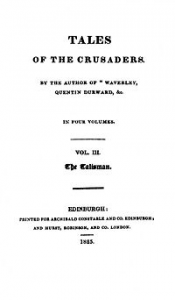 1825 The Talisman published. Inspired by the Lee penny. During the crusades of the 14th century the Lockharts brought back a precious heirloom, a touch piece which has been treasured ever since.
1825 The Talisman published. Inspired by the Lee penny. During the crusades of the 14th century the Lockharts brought back a precious heirloom, a touch piece which has been treasured ever since.
- Lockhart of Bar 1297 2Miller 2Simmons 2Choate 2Sorensen
It is known as the “Lee Penny”. At the Battle of Teba in Spain, Sir Simon Lockhart captured a Moorish Emir and received from the man’s mother as part of his ransom an amulet or stone with healing powers. The Prince’s mother told Sir Simon that the stone was a sovereign remedy against bleeding and fever, the bite of a mad dog, and sickness in horses and cattle. The stone is dark orange in colour and oblique in shape and was later set in a silver coin which has now been identified as a four penny piece from the reign of King Edward IV. The Lee Penny is kept in a gold snuffbox which was a gift from Maria Theresa of Austria, Empress of Austria to her general Count James Lockhart in 1789.
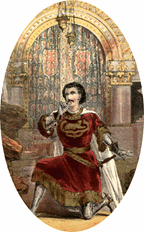 The fame of the Lee Penny spread through Scotland and Northern England and there are many recorded occasions when it was employed with apparent success. The coin was exempted from the Church of Scotland’s prohibition on charms and was lent to the citizens of Newcastle during the reign of King Charles 1 to protect them from the plague. A sum of between £1000 and £6000 was pledged for its return.
The fame of the Lee Penny spread through Scotland and Northern England and there are many recorded occasions when it was employed with apparent success. The coin was exempted from the Church of Scotland’s prohibition on charms and was lent to the citizens of Newcastle during the reign of King Charles 1 to protect them from the plague. A sum of between £1000 and £6000 was pledged for its return.
The Talisman Tales of the Crusaders.
First edition title page. The Talisman takes place at the end of the Third Crusade, mostly in the camp of the Crusaders in Palestine. Scheming and partisan politics, as well as the illness of King Richard the Lionheart, are placing the Crusade in danger. The main characters are the Scottish knight Kenneth, who is the fictional character of David Earl of Huntingdon, who did in fact return from the third Crusade in 1190, Richard the Lionheart, Saladin, and Edith Plantagenet, a relative of Richard.
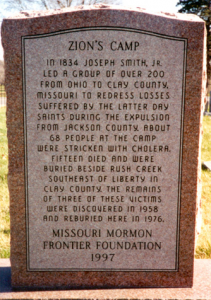 1834 Joseph Smith the Prophet, on Fishing River, Missouri. (clans Huntley, Hamilton, Mackenzie, Mack of Inverness, Malcolm King of Scots). The Prophet had come from Kirtland at the head of a party known as Zion’s Camp, bringing clothing and provisions.
1834 Joseph Smith the Prophet, on Fishing River, Missouri. (clans Huntley, Hamilton, Mackenzie, Mack of Inverness, Malcolm King of Scots). The Prophet had come from Kirtland at the head of a party known as Zion’s Camp, bringing clothing and provisions.
But first let my army become very great, and let it be asanctified before me, that it may become fair as the sun, and clear as the bmoon, and that her banners may be terrible unto all nations. Doctrine and Covenants 105.
Zion’s Camp. In 1834 Joseph Smith Jr. Led a group of over 200 from Ohio to Clay County Missouri to redress losses suffered by the Latter Day Saints during the expulsion from Jackson County. About 68 people at the camp were stricken with Cholera, fifteen died and were buried beside rush creek southeast of Liberty in Clay County. The remains of three of these victims were discovered in 1958 and reburied here in 1976. Missouri Mormon Frontier Foundation 1997.
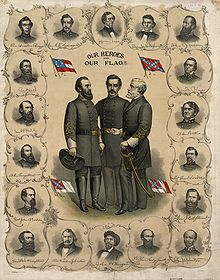 1865 Last shot fire in the American Civil War. The flag of Scotland features St Andrew’s saltire cross, also featured on the Confederate states battle flag.
1865 Last shot fire in the American Civil War. The flag of Scotland features St Andrew’s saltire cross, also featured on the Confederate states battle flag.
Four versions of the flag of the Confederate States of America are shown on this print from 1896. Standing at the center are Stonewall Jackson, P. G. T. Beauregard, and Robert E. Lee, surrounded by bust portraits of Jefferson Davis and Confederate Army officers.
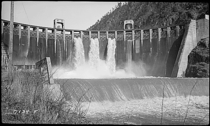 1930 Calderwood Dam’s two generating units come on line. Calderwood is a hydroelectric dam located along the Little Tennessee River in Blount and Monroe counties, in the U. S. state of Tennessee.
1930 Calderwood Dam’s two generating units come on line. Calderwood is a hydroelectric dam located along the Little Tennessee River in Blount and Monroe counties, in the U. S. state of Tennessee.
Calderwood Dam, photographed by TVA in 1939. 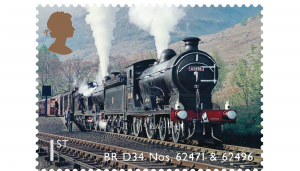 In 1909, Superintendent I.G. Calderwood oversaw the extension of a railway line from Chilhowee to what is now Calderwood (railroad bridge support columns are still visible in the river just downstream from the dam). Calderwood is an area of the Scottish new town East Kilbride, in South Lanarkshire.
In 1909, Superintendent I.G. Calderwood oversaw the extension of a railway line from Chilhowee to what is now Calderwood (railroad bridge support columns are still visible in the river just downstream from the dam). Calderwood is an area of the Scottish new town East Kilbride, in South Lanarkshire.
Locomotive. 8 March 2012 www.railpage.com.au
Two former North British Railway 4-4-0, “Glens”, LNER and BR Class D34, 62471, Glen Falloch and 62496 Glen Loy at Ardlui on 09 May 1959, the West Highland Line from Glasgow to Fort William and Mallaig.
Historic Scottish steam trains feature in the latest batch of collector stamps issued by Royal Mail. The locomotives, some of which date back to 1897, served the country before the introduction of diesel and electric trains in the 1960s. Classic Locomotives of Scotland. Philip Parker, Royal Mail stamps spokesman, said: “Scotland has an incredible railway heritage, not just in terms of its locomotive production, but also its iconic structures such as the Forth Bridge, then the world’s first major steel structure
1940 France surrendered. Britain’s situation was grim. In less than two months, Germany had conquered most of western Europe from Norway to the Pyrenees (SPAIN and France border). The fast-moving German army, supported by panzers and Stuka dive bombers, overwhelmed the Netherlands and Belgium in a matter of days. http://airforcemag.com/MagazineArchive/Pages/2015/July%202015/Their-Finest-Hour.aspx
 Messerschmitt Me 110s fly over the Arc de Triomphe in Paris, ( Arc in lower left corner) 1940. (akg-images) The swastika symbol is on the tail of the plane, barely visible. The auld alliance of Scotland and France from 1290’s to 1560 was renewed in the 1880s and continues through two world wars and NATO (North Atlantic Treaty Organization). The RAF would record 412 aerial kills using Browning’s (clans Hamilton and Browning)Machine Guns.
Messerschmitt Me 110s fly over the Arc de Triomphe in Paris, ( Arc in lower left corner) 1940. (akg-images) The swastika symbol is on the tail of the plane, barely visible. The auld alliance of Scotland and France from 1290’s to 1560 was renewed in the 1880s and continues through two world wars and NATO (North Atlantic Treaty Organization). The RAF would record 412 aerial kills using Browning’s (clans Hamilton and Browning)Machine Guns.
1961 Friedrich-Ebert-Halle (also known as Eberthalle) is an indoor arena located in Ludwigshafen, Germany, Kaempfert set a recording date for 22 June at Hamburg’s Friedrich-Ebert-Halle. Engineered by Karl Hinze, the session featured Sheridan and the Beatles singing Scottish folk song My bonnie Lies over the Ocean. Wikipedia- Obscure origin may be Charles Edward Stuart (‘Bonnie Prince Charlie’) after the defeat of the Prince at the Battle of Culloden in 1746 and his subsequent exile.My Bonnie lies over the ocean
My Bonnie lies over the sea
My Bonnie lies over the ocean
Oh, bring back my Bonnie to me…
Bring back, bring back
Oh, bring back my Bonnie to me, to me
1989 Circuit board stolen. Lockerbie bombing of Pan Am Flight 103 on 21 December 1988 when the wreckage fell on the town of Lockerbie in the Dumfries and Galloway region of south-western Scotland. In a sworn affidavit before a Zurich notary public, Lumpert stated that he had stolen a prototype MST-13 timer printed circuit board from Mebo and gave it without permission on 22 June 1989, to “an official person investigating the Lockerbie case”. sample he was asked to identify at the trial was a green 9-ply circuit board that Mebo had indeed supplied to Libya. Bollier wanted to pursue this discrepancy, but was told by trial Judge, Lord Sutherland, that he could not do so.
‘Fragments of a Samsonite suitcase believed to have contained the bomb were recovered, together with parts and pieces of circuit board identified as part of a Toshiba Bombeat radio cassette player, similar to that used to conceal a Semtex bomb seized by West German police from the Palestinian militant group Popular Front for the Liberation of Palestine – General Command two months earlier. Items of baby clothing, which were subsequently proven to have been made in Malta, were also thought to have come from the same suitcase.
The clothes were traced to a Maltese merchant, Tony Gauci, who became a key prosecution witness, testifying that he sold the clothes to a man of Libyan appearance. Gauci was interviewed 23 times, giving contradictory evidence about who had bought the clothes, that person’s age, appearance and the date of purchase but later identified Abdelbaset al-Megrahi. As Megrahi had only been in Malta on 7 December, that date was assumed to be the purchase date.
‘A circuit board fragment, allegedly found embedded in a piece of charred material, was identified as part of an electronic timer similar to that found on a Libyan intelligence agent who had been arrested 10 months previously, carrying materials for a Semtex bomb. The timer allegedly was traced through its Swiss manufacturer, Mebo, to the Libyan military, and Mebo employee Ulrich Lumpert identified the fragment at al-Megrahi’s trial. Mebo’s owner, Edwin Bollier testified at the trial that the Scottish police had originally shown him a fragment of a brown 8-ply circuit board, of a prototype timer which had never been supplied to Libya. On 18 July 2007, Ulrich Lumpert admitted he had lied at the trial
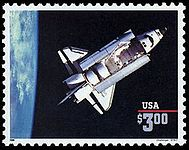 1995 Challenger Space Shuttle, STS-7, with the issuance of a 3-dollar Postage stamp.
1995 Challenger Space Shuttle, STS-7, with the issuance of a 3-dollar Postage stamp.
2012 Brave (Disney film) released. In Scotland, stories of fictional battles and legends have been  passed through generations. Merida (Kelly Macdonald), a skilled archer and impetuous daughter of King Fergus (Billy Connolly) and Queen Elinor (Emma Thompson), is determined to prove her worth. After ignoring an age-old custom sacred to Lords MacGuffin (Kevin McKidd), Macintosh (Craig Ferguson) and Dingwall (Robbie Coltrane) [there actually was a Dingwall castle in Ross and Cromarty], Merida inadvertently causes controversy and chaos in the kingdom.
passed through generations. Merida (Kelly Macdonald), a skilled archer and impetuous daughter of King Fergus (Billy Connolly) and Queen Elinor (Emma Thompson), is determined to prove her worth. After ignoring an age-old custom sacred to Lords MacGuffin (Kevin McKidd), Macintosh (Craig Ferguson) and Dingwall (Robbie Coltrane) [there actually was a Dingwall castle in Ross and Cromarty], Merida inadvertently causes controversy and chaos in the kingdom.
The story takes place during the 10th century in the highlands of Scotland. Dingwall actually exists and had a battle recorded there.
Check out that hair doo, and perm.
2016 Brexit. British Exit from the European Union. The Voting Areas are being prepared, with 32 in Scotland, The local counts in the voting areas will begin from 2200 BST (WEST) on Thursday 23 June 2016 after polling stations have closed. Recounts within “voting areas” are permitted when circumstances require under the instructions of the “Counting officers (CO).” It is the first time that a United Kingdom referendum is be counted overnight as both the previous 1975 EEC Referendum and the 2011 AV Referendum were counted during the course of the following day after polling stations closed.
And it’s all rooted on immigration issues and how these countries have growing members of the population who are now aware that every one of these countries in the European Union is at risk of losing their own identity and sovereignty. They’re still gonna have borders, but they won’t matter. You’ve heard the globalists and their desire for New World Order and the end of nation states. That’s really what the elites in the European Union want, and they’ve got their supporters here in the US.
http://www.rushlimbaugh.com/daily/2016/06/21/the_best_explanation_of_brexit_you_ll_get
Disclaimer: The author of each article published on this web site owns his or her own words. The opinions, beliefs and viewpoints expressed by the various authors and forum participants on this site do not necessarily reflect the opinions, beliefs and viewpoints of Utah Standard News or official policies of the USN and may actually reflect positions that USN actively opposes. No claim in public domain or fair use. © John Choate
Utah Standard News depends on the support of readers like you.
Good Journalism requires time, expertise, passion and money. We know you appreciate the coverage here. Please help us to continue as an alternative news website by becoming a subscriber or making a donation. To learn more about our subscription options or make a donation, click here.
To Advertise on UtahStandardNews.com, please contact us at: ed@utahstandardnews.com.


Comments - No Responses to “June 22nd Scots Book of Days”
Sure is empty down here...